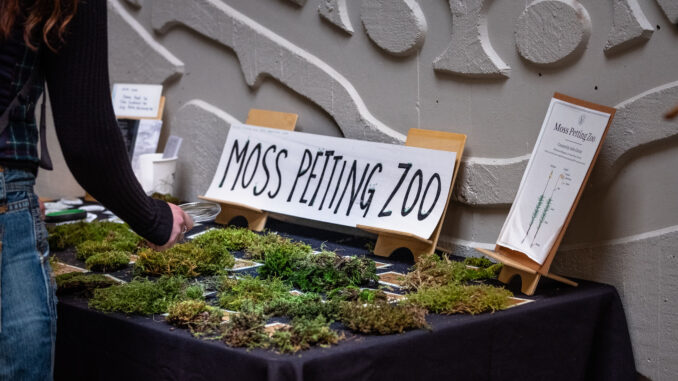
From Feb. 12-16, another beautiful Moss Appreciation Week at Lewis & Clark passed with several student-led organizations coming together to make it an extraordinary event. This intricate affair included, but was not limited to, a moss petting zoo, moss poetry, an Investigate a Moss Clump Workshop, a slug and snail race and a keynote lecture by Assistant Professor of Biology at San Francisco State University Jenna Ekwealor.
The Natural History Club founded Moss Appreciation Week in 2019 and continues to be its main organizer. Deanna Sunnergren ’24 is one of the co-leaders of the Natural History Club and helped coordinate the multi-department effort.
“It was just a vague inkling we had in the fall: ‘What if we got people to read moss poetry and say moss in different languages?’ We just kept reaching out to people and people kept saying yes, and I think that was a really rewarding thing about Moss Week this year,” Sunnergren said.
One such collaboration that combined theatre and science saw Acting III students give dramatic readings for historical descriptions of moss. Another showcase, “Moss in Many Languages,” displayed worldwide, multilingual interpretations of the word for what we call “moss.”
“‘Moss in Many Languages’ was a huge project and it involved going to a bunch of students and a bunch of students’ family (and) friends asking anyone who knew different languages, ‘Can you say moss in your language?’” Sunnergren said.
The Natural History Club also hosted a gastropod race on Thursday, Feb 15. Supernova, a brown garden snail, came in first while Slug O’War, a leopard slug, came in second.
“I’m really grateful for everyone who came out. All the departments’ support was wonderful,” Sunnergren said.
Of course, for any student passing through Watzek Library during Moss Appreciation Week, the Moss Petting Zoo was hard to miss.
“We actually had to bring in an expert to curate (the Moss Petting Zoo), because it requires such a vast knowledge of mosses to be able to identify to species level,” Sunnergren said.
Coupled with the petting zoo were written tributes to moss in the form of moss poems. One of these moss poets is Emma Krall ’25, who watered the moss of the Moss Petting Zoo and is a thorough appreciator of Moss Appreciation Week.
“I think (Moss Appreciation Week) is so awesome. It’s like 50% of the reason I go to LC. I remember hearing about it from one of the admissions visitors who came to my high school and they were like ‘Oh yeah we’ve got all these crazy programs, we’ve got Moss Appreciation Week’ and I was like that’s gotta be a joke. And then it wasn’t,” Krall said.
Krall wanted her poem to highlight the symbolic role of moss in the cycle of life.
“I love that (moss) is kind of like a sign of life after death in a way,” Krall said. “When you go to Tryon you’ll notice that there are a lot of dead trees that are just weighed down with green moss and I just think it’s really special. It’s kind of inspiring.”
Another moss poet, Cleo Lockhart ’25, shared what inspires them about moss.
“(Moss) can grow in unbeautiful places, but it itself is something that is really beautiful,” Lockhart said. “It’s comforting, and it has this association of peace and goodness. So whenever I see it around, it makes me take a second and (think), even if things are dark or difficult or don’t feel good, beautiful things can grow here and there can be selfness here.”
Lockhart contrasted the natural greenness of moss with the green commonly seen in the many suburbs of America.
“I’m a big hater of a sterilized grass lawn,” Lockhart said. “Moss is an alternative green coating that makes things look really beautiful but actually is healthy, and it’s supposed to be there and actually has this symbiosis with everything around it.”
Although Moss Appreciation Week has completed its annual course, moss remains a cultural staple of LC and a beacon of inspiration for students and the environment.
“It’s a good metric for how the ecosystem is doing by looking at the moss,” Sunnergren said. “When you actually look at moss, it’s a bunch of little individuals. You’re never looking at one individual plant and so it’s a very community-oriented organism. It’s built on its brothers and sisters around it. It’s not just there by itself.”
Subscribe to the Mossy Log Newsletter
Stay up to date with the goings-on at Lewis & Clark! Get the top stories or your favorite section delivered to your inbox whenever we release a new issue.

Leave a Reply